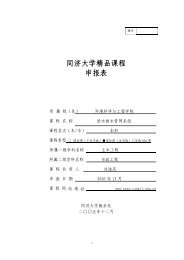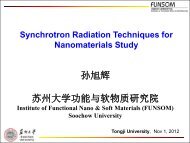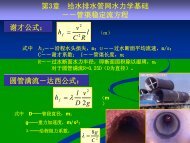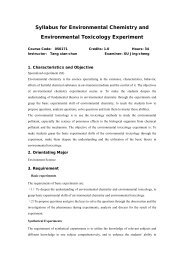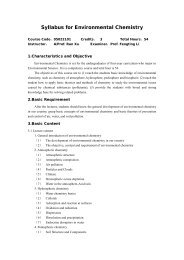Environmental Chemistry
Environmental Chemistry
Environmental Chemistry
You also want an ePaper? Increase the reach of your titles
YUMPU automatically turns print PDFs into web optimized ePapers that Google loves.
Chart 4.1<br />
main types of primary minerals in soil<br />
Primary minerals Properties<br />
silicates<br />
oxides<br />
sulphides<br />
phosphates<br />
Including minerals such as feldspar (e.g. KalSi 3 O 8 ), mica<br />
(e.g. K(Si 3 Al)Al 2 O 10 (OH) 2 ), pyroxene (e.g. (Mg,<br />
Fe) 7 (Si 4 O 11 ) 2 (OH) 2 ) and olivine (e.g. (Mg, Fe) 2 SiO 4 ), most of<br />
which are unstable, easy to be weathered and to release<br />
elements such as sodium, potassium, calcium, magnesium<br />
and iron, etc. that are aborpt by plants and form new<br />
secondary minerals.<br />
Including rutile (TiO 2 ), quarts (SiO 2 ), hematite (Fe 2 O 3 ) which<br />
are highly stable, difficult to be weathered and contribute<br />
little to nutrition for plants.<br />
Mainly in the forms of alkaline compounds, ad. pyrite and<br />
marcasite. These two minerals are isomeric, easy to be<br />
weathered and the main source of sulphur element in soil.<br />
Phosphorite is the most widespread phosphate mineral in<br />
soil, including flurapatite (Ca5(PO4)3F) and (Ca5(PO4)3Cl),<br />
followed by iron phosphates, aluminum phosphates and<br />
other phosphates. It is the main source of phosphorus in<br />
soil.



